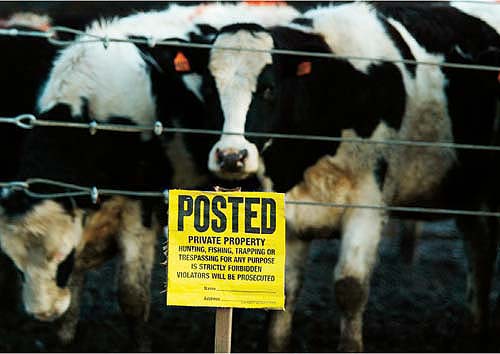All Issues
UC expertise helps guide BSE response
Publication Information
California Agriculture 59(4):195-196.
Published October 01, 2005
PDF | Citation | Permissions
Full text
On Dec. 23, 2003, the U.S. Department of Agriculture announced the first U.S. case of bovine spongiform encephalopathy (BSE, or mad cow disease) in a cow from Washington state. Within days, 53 trading partners closed their borders to U.S. beef exports. Cattle futures plummeted, and consumption of beef declined as confusion and concern swept the country. The afflicted animal became known as “the cow that stole Christmas,” as many experts from UC ANR joined others in responding during the holidays in TV, radio and print interviews.
BSE is a new disease first recognized in 1986; there is no evidence it existed prior to 1985. It joins a unique family of diseases, the transmissible spongiform encephalopathies (TSEs) that had been previously recognized, in some cases for hundreds of years, in other species. The emergence of BSE as a foodborne disease in the United Kingdom was linked to feeding cattle a protein supplement made from rendered cattle and sheep parts. It turned out that these were contaminated with a new and abnormal prion protein. The discovery of prion proteins represents a fundamental and revolutionary change in the dogma of infectious disease: no longer does an infectious agent need to rely on RNA or DNA to reproduce and create disease. TSEs are caused when small, naturally found proteins become misshapen from association with the abnormally shaped prion protein.
In the mid-1990s an association between BSE and a new disease in humans, variant Creutzfeldt-Jakob disease (vCJD), was identified as a foodborne zoonosis (a disease shared by humans and animals). Research has shown that interspecies transmission is inefficient and dependent on a number of variables. These include the level and age of exposure, TSE donor strain, and amino-acid sequence of the victim's normal prion protein. (All but one vCJD case have been in people homozygous for methionine at prion protein codon 129, a genotype found in 38% of the U.K. population.)
While the relative risks of vCJD from consumption of foods contaminated with the abnormal protein is extremely small, it is postulated that in the United Kingdom from the late 1980s to the mid-1990s, there was a massive level of abnormal prion contamination in certain meat products; as many as 800,000 diseased carcasses may have entered the human food chain prior to the emergence of the disease in humans. This combined with a cultural preference for food products that at that time were likely to contain the contaminated tissues. The tragic result is that since vCJD emerged in the 1990s, nearly 200 people worldwide have died from this disease.
Almost 200,000 cattle were killed as part of the effort to control the BSE outbreak. The impacts were huge, including the destruction of legacy herds representing generations of selective breeding, increased suicides among farmers who experienced the loss of their life's work, economic crisis in the U.K. farm community, and the eventual failure of former Prime Minister John Major's government due in part to the loss of public confidence. New BSE cases continue to decline and it appears that the aggressive response pursued in the United Kingdom will control this disease.
The Washington state animal, born and raised in Canada and imported to the United States as an adult, was likely exposed to abnormal prions in contaminated feed as a calf — Canada is known to have imported protein supplements from the United Kingdom during the danger period — and was in the long incubation phase before being imported. No additional cases were identified in an exhaustive investigation and testing of the majority of its herd mates and offspring.
Cattle in Mabton, Washington, were quarantined by U.S. officials after a Holstein cow from the farm was found to be infected with mad cow disease. The finding had major implications for U.S. beef exports.
In 2005, a 12-year-old cow from Texas was confirmed with BSE. The investigation of the circumstances associated with this animal is ongoing. The cow was born prior to the U.S. feed ban and was likely exposed as a young calf. Key questions under investigation include whether the animal traveled outside of the United States or if it might have been exposed to imported feed supplements. The recently announced third suspect from an unidentified state had tests run in the United Kingdom and was found to be negative for BSE.
While BSE is unlikely to pose the significant threat to animal or human health in the United States that it did in the United Kingdom, due to our production systems and feed regulations, it appears BSE will be an issue for our beef industry and the U.S. economy for some time. Currently 59 countries have import bans or restrictions on U.S. beef or live animals, including several that represented major export markets for California beef. Whether BSE becomes a larger issue depends on what the investigation discovers about the origin and lifetime travels of the Texas animal, and whether any new positive animals are discovered. If sporadic cases occur in cattle in a manner similar to people, we can anticipate intermittent diagnoses of BSE from the surveillance program.
UC has been at the forefront of research on TSEs for many decades, trying to understand the nature and cause of the disease, and to discover potential diagnostic and therapeutic approaches. UC San Francisco neurologist Stanley Prusiner's groundbreaking work (leading to the Nobel Prize in 1997) identified a morphological change in prion proteins that are normally found as cell-wall components in the central nervous system. A change in the three-dimensional conformation of the protein creates the abnormal prion form, which is capable of inducing other normal proteins to become misshapen. This change in structure renders the altered proteins resistant to normal degradation processes, resulting in abnormal protein accumulation and subsequent interference with cellular function. TSE diseases represent a revolutionary concept — infectious agents that are out-of-reach of the victim's immune response. We will need equally revolutionary diagnostic and therapeutic methods to address them.
There have been and continue to be TSE-relevant activities across ANR's research-outreach continuum in campuses and counties. The California Animal Health and Food Safety Laboratory, managed by the UC Davis School of Veterinary Medicine for the California Department of Food and Agriculture, tests thousands of samples annually. The Center for Food Animal Health and its collaborators have funded projects looking for a rapid and accurate ante-mortem diagnostic test. Current tests rely on brain tissue samples harvested after death. UC scientists are also evaluating new methods to destroy prions, as well as technologies to monitor ruminant feed by rapidly identifying contamination by other-ruminant proteins ( see page 212 ).
ANR faculty also provide science-based information for the public, policy-makers and industry on BSE and the other TSEs. Scientists in an array of disciplines provide expertise on the safety of the food supply, human and animal health, testing methods, animal tracking, disease surveillance and trade agreements.
Whatever the scope of the BSE problem proves to be, it has provided an opportunity to evaluate our food safety response systems. For instance, we have seen that animal trace-back and trace-forward are critical tools for investigating and controlling disease outbreaks. Effective tracing requires the ability to follow an afflicted host back to the likely source of infection, and to trace forward to identify others that may have been exposed. This is a formidable task when animals and animal products move through many hands, across multiple borders, all the while commingling with others on their way to their destination. An effective animal-identification system is an essential ingredient in protecting our food supply, and deserves ANR's multidisciplinary attention. Also, the loss of rendered protein supplements has created a demand for new protein sources equivalent to an estimated 3 million additional acres of soybean production nationally. An alternative safe use of ruminant protein that is no longer available to be recycled as feed supplements involves a number of researchable issues.
Above, a Japanese meat dealer examines cattle carcasses at a wholesale meat market in Tokyo. Between 1989 and September 2005, BSE cases were confirmed in Austria, Belgium, Canada, Czech Republic, Denmark, Finland, France, Germany, Greece, Ireland, Israel, Italy, Japan, Liechtenstein, Luxembourg, Netherlands, Poland, Portugal, Slovakia, Slovenia, Spain, Switzerland and the United States, as well as the United Kingdom (source: World Organisation for Animal Health [OIE]).
The emergence of BSE as a zoonotic disease represents just one reminder that we share the planet with many microbes and other potential health threats. ANR scientists represent the disciplinary breadth — as well as the combination of research, development and delivery — to play significant roles in finding answers to these challenges in the days and months to come.
A brief history of BSE
First recognized in 1986, bovine spongiform encephalopathy (BSE, or mad cow disease) is one of several similar but not identical diseases known as transmissible spongiform encephalopathies (TSEs). TSEs are characterized by progressive degeneration of the central nervous system. All have long incubation periods (4 to 8 years average in cattle, and up to 30 years reported in humans), evoke no immune response and are inevitably fatal.
Different TSEs affect several different mammalian species including humans (Creutzfeldt-Jakob disease, Gerstmann-Straussler-Scheinker syndrome, fatal familial insomnia, kuru), mink (transmissible mink encephalopathy), sheep and goats (scrapie), and mule deer and elk (chronic wasting disease). About 15% of human TSEs are heritable, with 85% considered sporadic (about one person per million per year will be diagnosed with a sporadic TSE on every continent worldwide).
In the mid-1990s, U.K. scientists linked the consumption of food containing BSE-diseased cattle protein from specific organ systems to a new human disease, vCJD (variant Creutzfeldt-Jakob disease). As many as 900,000 U.K. cattle might have been infected with BSE between 1984 and 1995, with close to 800,000 carcasses entering the human food chain prior to recognition of the problem as a foodborne zoonosis (disease shared by humans and animals).
Studies implicated the feeding of meat-and-bone meal contaminated with the abnormal BSE prion protein to young cattle. Changes in rendering practices in the United Kingdom in the late 1970s and early 1980s may have allowed the infectious particle, a prion (“proteinaceous infectious particle,” see page 206 ) to be amplified in the production of meat-and-bone meal. The export from the United Kingdom of rendered animal feed products contaminated with BSE prions is considered the source of BSE affecting native cattle in other countries. The use of meat-and-bone meal as a protein supplement for ruminants (four-stomached animals including cattle, sheep and goats) had been common practice for more than 50 years prior to the emergence of BSE. Historical tissues have been examined and there is no evidence that the disease existed prior to 1985.
The United States responded as early as 1989, well before there was any evidence that this was a zoonotic disease, with import bans designed to keep the prion contaminant out of the country. Between 1989 and the present, there have been several waves of regulation by the U.S. Department of Agriculture and the U.S. Food and Drug Administration, some in response to requests from livestock and professional animal-health organizations to minimize the nation's risks of importing this disease. Others, such as the slaughter surveillance program initiated in 1990, were designed to monitor the food chain.
After confirmation of the first U.S. BSE case in December 2003, the United States vastly expanded its slaughter surveillance program. While testing is mandatory for cattle condemned at slaughter, the majority of the program is voluntary. Surveillance now includes as many cows as possible from the highest-risk populations, such as downer cattle — those unable to stand and walk on their own. (While BSE-affected cattle become downers as the disease progresses, other downers are disabled for a host of reasons having nothing to do with BSE.) From June 2004 through September 2005, more than 470,000 samples had been examined with only one positive. Scientists in the California Animal Heath and Food Safety Laboratory at UC Davis perform more than 10% of these tests.
A key to containing the outbreak in the United Kingdom included the killing and stringent disposal of positive animals and a ban on using protein from ruminants in protein supplements for other ruminants. The United States banned ruminant-source protein in ruminant feeds in 1997 (following a voluntary ban in 1996).
One U.S. animal was confirmed with BSE in December 2003. This older dairy cow was imported to the United States from Canada and was likely exposed to prions while a calf in Canada. A second positive animal was identified in 2005 in Texas as part of the slaughter surveillance program. This beef cow was about 12 years old and investigations are under way relative to its source of exposure. All tissue from these animals was destroyed with no resulting contamination of the animal or human food chain.






![Above, a Japanese meat dealer examines cattle carcasses at a wholesale meat market in Tokyo. Between 1989 and September 2005, BSE cases were confirmed in Austria, Belgium, Canada, Czech Republic, Denmark, Finland, France, Germany, Greece, Ireland, Israel, Italy, Japan, Liechtenstein, Luxembourg, Netherlands, Poland, Portugal, Slovakia, Slovenia, Spain, Switzerland and the United States, as well as the United Kingdom (source: World Organisation for Animal Health [OIE]).](http://ucanr.edu/sites/calagjournal/archive/?file=img5904p196.jpg)


